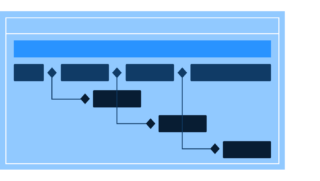
Team Feedback
Feedback is vital to building and sustaining high-performing teams and team members, taking shape through informal, real-time conversations and formal, recurring touch points, across sponsors, leaders, and team members.
# of people
All team members, including sponsors
Duration
2-3 hours per month
Difficulty level
Intermediate
Skillsets needed
Communication, collaboration
About
Is your team consistently underperforming? Is there dysfunction, or even animosity between team members? Infrequent and/or poorly-constructed feedback could be a primary culprit.
As with the Design Review Play, it is important to set expectations for when and how to provide feedback to sponsors, leaders, and peers. Equally important, leaders must ensure that the team allocates and spends sufficient time to provide and address feedback. This play provides you and your team with a feedback framework to apply and customize, leading to greater results and a more open, collaborative environment.
Materials
- Feedback expectations content
- Retrospective template
- Feedback form tool
- Meeting room with projector/large screen or video conference software
Benefit of following this play
Providing frequent, well-constructed feedback results in stronger relationships between team members, a more-positive environment, high levels of collaboration, increased quality and efficiency, and, ultimately, greater team outcomes.
This play is for
Leads:
Leaders (e.g., Directors, Managers)
Involved:
Sponsors, all team members, across disciplines
How to run the play
Pro Tip
Consult with your Human Resources team when establishing feedback expectations and when putting the various feedback channels into practice.
Step 1: Set expectations on when feedback should be provided
At the beginning of the project, release cycle, etc., and on a period basis (e.g., monthly), set and remind the team of expectations on when feedback should be provided.
This starts with informal, real-time feedback, which should be frequently and consistently provided—E.g., Immediately following a key presentation or the sending of an important email.
It also includes setting expectations for team retrospectives, which should occur periodically (e.g. monthly) with all team members to align on what is going well and how to improve. Schedule recurring retrospectives, including when and where feedback should be documented (including reminders to do so, leading up to each retro).
Sometimes, informal, one-on-one or team check-ins between leaders and their team members are needed to share feedback with each other and discuss trends in the project, such as if scope, priorities, and timelines are being clearly set.
Expectations also need to be set for formal, structured feedback, which should be an input to performance reviews. E.g., Quarterly/end-of-project/release feedback form submissions for leaders and team members, quarterly one-on-ones between leaders and their team members, quarterly/end-of-project/release feedback forms and sessions with sponsors. Formal feedback should not be a surprise to team members – hopefully, similar feedback has already been provided informally.
All expectations should be documented, whether it be in the team or project’s operating model, Wiki, plan, or wherever teams often work.

Step 2: Set expectations on how feedback should be provided and received
When setting expectations on when to provide feedback, also set and remind the team of expectations on how feedback should be provided.
For both types of feedback (i.e., informal and formal):
- Don’t just focus on constructive critique – celebrate successes and strengths/give kudos. When you are providing constructive critique, don’t dwell too long on when/how the reviewee underperformed – only do so until you feel there is alignment on what is driving the feedback. Instead, shift focus on discussing and collaboratively establishing tactical ways to improve.
- Feedback should be descriptive and not evaluative. Not: “That wasn’t good,” but: “This is how you did it, and that led to…”
- Objectivity is difficult, but not impossible – do your best to be self-aware and avoid personal bias.
- When providing constructive feedback, be direct and clear. Focus on providing the feedback carefully and respectfully to avoid triggering the recipient’s defense mode. Harsh feedback may be counterproductive. First, note the time and place when the negative behavior occurred. Describe the behavior. Then describe the impact the behavior had in terms of the feedback provider/s thoughts, feelings, or actions. Ask for their thoughts on what happened and why. It could be that their actions were justified and that your picture of what happened is incomplete. Regardless, taking the time to understand their position will create empathy and deeper insight.
- Make sure that the reviewee understands what they need to change and has a clear path to addressing the issue.
For informal feedback, don’t expect others to consistently provide feedback – ask for it! Set recurring reminders and one-time reminders (e.g., after a key presentation) to ask for and/or provide feedback. Kudos can and should be provided in a group setting, whereas constructive critique should be provided in a one-on-one format (vs in a group setting), preferably in-person or on a video call (vs chat).
Retrospectives are informal, in that they don’t directly feed into performance reviews, but are not quite real-time. As such, you could say that they span the informal and formal feedback realms. Retrospectives, and the feedback provided through them, should focus on workstreams, activities, and how teams collaborate – not a specific team or individual. Set expectations that each participant be engaged throughout the session (even if discussion appears to be unrelated to their team/role, their suggestions or best practices might still be applicable). Document action items in shared ticketing systems (e.g., Jira).
For formal feedback, align on a review framework (if not already established by Human Resources), such as what dimensions will be considered (e.g., Job Knowledge, Interpersonal Skills) and how each dimension will be scored (e.g,. a 5-point scale, ranging from 5-Sets a New Standard to 1-Unacceptable). Define each dimension and scoring option, and provide examples where possible. Create a form for reviewers to complete (for providing feedback to both leaders and direct reports), along with the definitions and examples recommended above. Include free-text fields for reviewers to add context to each answer, as well as for cross-discipline comments. After providing the team with sufficient time to complete the forms, hold one-on-one sessions with leader(s) and their team members to discuss feedback that each provided, focused on alignment and establishing/documenting strengths and tactical ways to improve. If needed, leaders can meet with HR ahead of the review session to prepare and align on how to discuss/deliver difficult feedback. Additionally, leaders can meet with HR after the review to discuss how the meeting went, challenges and insights, and opportunities for improvement during subsequent reviews. Finally, follow a similar process with team/project stakeholders – request that they fill out a form, and then meet to align on the feedback and tactical ways to improve.
Again, all expectations should be documented, whether it be in the team or project’s operating model, Wiki, plan, or wherever teams often work.

Step 3: Execute and... gather feedback
Leaders need to ensure that expectations are being met. They should do so by periodically checking in with others to ensure that real-time feedback is being provided, and also set the standard by frequently providing real-time feedback. They should also lead the retrospectives, ensuring attendance and engagement, and that the resulting action items are logged and completed. They also need to track that the formal feedback forms are being completed and one-on-one sessions are being held, and that the scores (and accompanying comments) are truly reflective of the completed work (i.e., prevent sugar-coating, ensure consistency across team members on how scoring is approached).
Finally, the leader should ask the team for feedback on the expectations. Perhaps the cadences of formal feedback need to be revised, or scoring definitions/examples need improvement.

To recap
- Feedback is vital to building and sustaining high-performing teams and team members
- Feedback should be informal and formal
- Informal feedback could be real-time, monthly check-ins, and retrospectives
- Formal feedback should be structured, occurring via forms and one-on-one sessions, and feed into future performance reviews
Set expectations on when and how feedback should be provided, and refer back to/reinforce those expectations periodically
- Leaders should ensure that expectations being met, but also adjusting expectations based on team feedback
Happy feedback-ing!